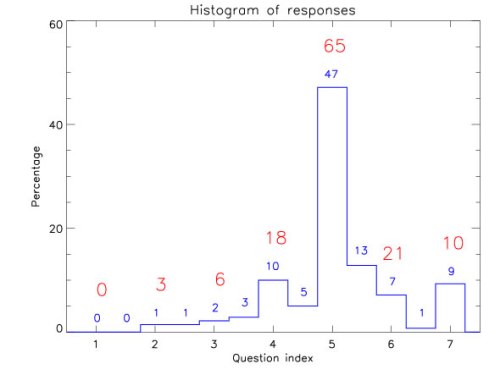As a follow up to the post
Survey Of Climate Scientists Announced On Hans von Storch’s Weblog “Die Klimazwiebel”
I have posted today on the survey that Fergus Brown, James Annan and I completed two years ago which we reported in
Brown, F., J. Annan, and R.A. Pielke Sr., 2008: Is there agreement amongst climate scientists on the IPCC AR4 WG1?. The summary plot of our data is given below using the following choice of answers:
1. There is no warming; it is a fabrication based on inaccurate/inappropriate measurement. Human activity is not having any significant effect on Climate. The data on which such assumptions are made is so compromised as to be worthless. The physical science basis of AGW theory is founded on a false hypothesis.
2. Any recent warming is most likely natural. Human input of CO2 has very little to do with it. Solar, naturally varying water vapour and similar variables can explain most or all of the climate changes. Projections based on Global Climate Models are unreliable because these are based on too many assumptions and unreliable datasets.
3. There are changes in the atmosphere, including added CO2 from human activities, but significant climate effects are likely to be all within natural limits. The ‘scares’ are exaggerations with a political motive. The undue emphasis on CO2 diverts attention away from other, important research on climate variability and change.
4. There is warming and the human addition of CO2 causes some of it, but the science is too uncertain to be confident about current attributions of the precise role of CO2 with respect to other climate forcings. The IPCC WG1 overestimates the role of CO2 relative to other forcings, including a diverse variety of human climate forcings.
5. The scientific basis for human impacts on climate is well represented by the IPCC WG1 report. The lead scientists know what they are doing. We are warming the planet, with CO2 as the main culprit. At least some of the forecast consequences of this change are based on robust evidence.
6. The IPCC WG1 is compromised by political intervention; I agree with those scientists who say that the IPCC WG1 is underestimating the problem. Action to reduce human emissions of CO2 in order to mitigate against serious consequences is more urgent than the report suggests. This should be done irrespective of other climate and environmental considerations.
7. The IPCC WG1 seriously understates the human influence on climate. I agree with those scientists who say that major mitigation responses are needed immediately to prevent catastrophic serious warming and other impacts projected to result from human emissions of CO2. We are seriously damaging the Earth’s climate, and will continue to face devastating consequences for many years.

Our conclusions were
1. The largest group of respondents (45-50%) concur with the IPCC perspective as given in the 2007 Report.
2. A significant minority (15-20%), however, conclude that the IPCC understated the seriousness of the threat from human additions of CO2.
3. A significant minority (15-20%), in contrast, conclude that the IPCC overstated the role of human additions of CO2 relative to other climate forcings.
4. Almost all respondents (at least 97%) conclude that the human addition of CO2 into the atmosphere is an important component of the climate system and has contributed to some extent in recent observed global average warming.
Our report is discussed further in these posts
Weblogs By My Coauthors Of Our Rejected EOS Forum Article
“Of consensus and consistency”
Our survey is consistent with that reported on Hans von Storch’s weblog in that there is a wider diversity of views on the role of humans within the climate system than is commonly reported. Our survey [which was not permitted to be published in EOS; see] is also another example of the suppression of attempts to poll the climate science community with respect to their views of natural climate variability and change, and of the role of humans in the climate system than has been communicated by the IPCC.
To my knowledge, no professional organization, such as the American Meteorological Society, the American Geophysical Union, and the European Geosciences Union, as just three examples, have undertaken such surveys of their membership in the preparation of their statements on climate science. This is a very much overdue requirement for the next IPCC assessment.
